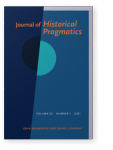Vol. 22:1 (2021) ► pp.34–68
Pragmatic uses of ‘I say’ in Latin
This paper examines the pragmatic uses and functions of the Latin verb inquam (‘I say’) and compares it with three synonyms – dico (‘I say, I speak, I declare’), loquor (‘I speak, I say, I utter’) and aio (‘I say yes, I say, I affirm’). Verbs of speech and thought in the first person are (cross-linguistically) a source of pragmatic markers, because the first person of these verbs is necessarily speaker-orientated and is also apt for expressing the speaker’s attitude. This can be seen in English pragmatic markers developed from verbs, such as I mean, I think and I say, and Romance ones, such as the Italian credo (‘I think’). Latin verbs with the meaning ‘I say’ (henceforth used as a hypernym for all of the verbs examined herein) also show pragmatic uses, as is clear from Latin dictionaries. The issue addressed in this paper is the extent to which they are interchangeable and how advanced they are in their development towards becoming pragmatic markers. For this goal, the paper will focus on a variety of pragmatic uses of ‘I say’, the contexts in which they appear, and the influence of genre on their distribution. Drawing on Bazzanella (2006) and Ghezzi (2014), the pragmatic uses will be divided into three main categories: textual, cognitive and interactional. It will be shown that the border between different pragmatic functions or readings is not neat and one instance can have various pragmatic uses at the same time.
Article outline
- 1.Introduction: Theoretical background
- 1.1Pragmatic markers and functions
- 1.2Reporting as a pragmatic function
- 1.3Grammaticalization as a mechanism of the development of pragmatic markers
- 1.4Latin pragmatic markers developed from verbs
- 2.Data
- 2.1Description of the corpus
- 2.2Use of ‘I say’
- 3.Characteristics of individual verbs
- 3.1
Inquam
- 3.1.1Textual pragmatic uses
- 3.1.2Cognitive pragmatic uses
- 3.1.3Interactional pragmatic uses
- 3.2
Dico
- 3.2.1Textual pragmatic uses
- 3.2.2Cognitive pragmatic uses
- 3.2.3Interactional pragmatic uses
- 3.3
Loquor
- 3.3.1Textual pragmatic uses
- 3.3.2Cognitive pragmatic uses
- 3.3.3Interactional pragmatic uses
- 3.4 Aio
- 3.1
Inquam
- 4.Comparison of pragmatic uses and genres
- 5.Grammaticalization
- 6.Conclusion
- Acknowledgements
- Notes
-
References -
Texts and dictionaries
